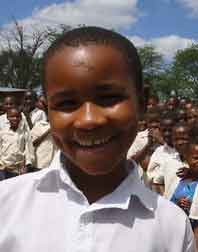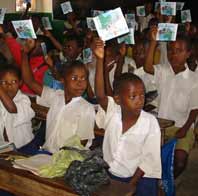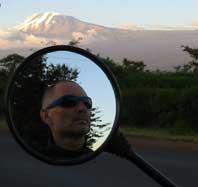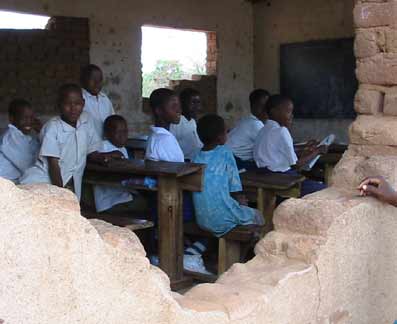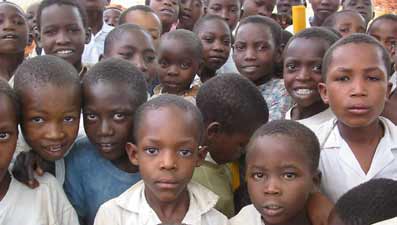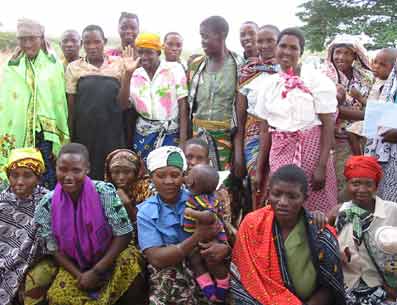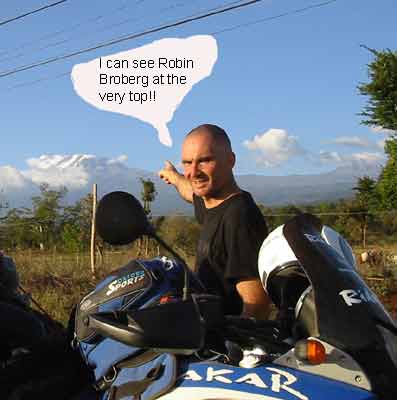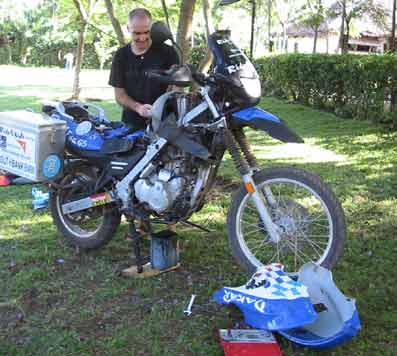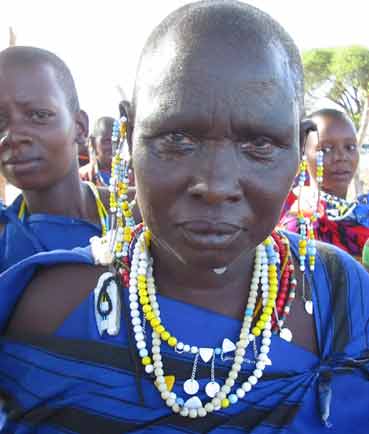The magnificent
Mt Kilimanjaro!
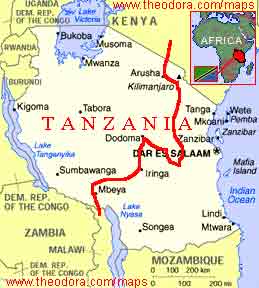
through
it easily enough, as usual there were hundred of guys around trying to get you
to change money, as I was about to change my left over money from Malawi into
Tanzanian money, one of the custom officer stopped us telling me that that guy
was a crook and introduced me to one that he trusted. As it turned up the bastard
ripped me off of US$5.00, it's not losing the money that pisses me off but to
get caught, I do know better, I have had enough experience in that kind of transaction,
but then again, when you have to deal with different currencies in a pretty
stressing situation it's easy to let your guard down. I don't have to tell you
that the custom officer was nowhere to be seen.
The first 100km in Tanzania were quite high in the mountains, completely different
scenery, tropical I would call it with a lot of bananas, it got very foggy and
cold, it was strange to see such a contrast in such a short time after all the
sunshine and the heat of Malawi but it did not last and as soon as I got down
from the mountain things were back to normal, hot and dry.
The day before I had meet an overland truck (they take tourist around southern
Africa for 4 to 6 weeks) the driver had told me about a place in the middle
of nowhere where it is possible to camp, I found the place, put up my tent and
not long after they arrived. As they had Americans on board they had decided
to celebrate Thanks Giving and to cook a turkey. Thank you guys for inviting
me, without you I would have starved. It was a very enjoyable evening, eating
and talking around the camp fire.
Welcome
to Tanzania.
Tanzania is about the size of South Australia and has a population of around
38 million people. It has some of the largest wildlife herds on the continent
as well as Mt Kilimanjaro (the continent's highest peak at 5892m) and the island
of Zanzibar with its exotic Stone Town.
The capital used to be Dar es Salam but now Dodoma is the official capital since
1974.
Tuesday 26 Nov. 02
I got to the border at around nine in the morning, overcast and little rain,
I went
The
next day I was up at 5am, still dark, packed everything and off I went. An hour
later I reached Iringa, while refueling I asked one guy for the direction to
Dodoma. He told me that there were two ways, the long one, 600km, on a beautiful
road or the short cut, 220km, on a dirt road. "How good is the dirt road"
I asked, "very good, no problems on your bike" he says. So I decided
to go on the dirt road, after all its only 220km. That
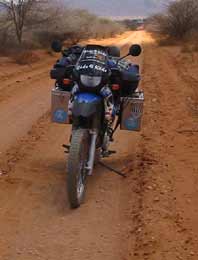
was
a BIG MISTAKE. It took me 8 hours to reach Dodoma, the 220km became 280km and
the road was so bad that sometime I could not do more than 15km/h, on average
only 40km/h. I also fell off twice.
When I first started I thought, it will get better soon, I would ask people
"how is the road further up?" They would answer "very good, no
problem" there were hardly any one on the road, so I think not many people
ever use it so no one knows what it is like. After 4 hours, the road became
all sandy, with just enough room for me to go through, doing 15km/h, I started
to worry, at that speed I would never reach Dodoma, should I turn around? Which
I could not do anyway, no room to turn around, maybe the road is good further
up, as it turned up the road
did get a little better but still it was a
hell of a job, probably good training for Ethiopia and Sudan.
I arrived in Dodoma at 4pm, exhausted, covered with dust and started to look
for a hotel with room to park my bike safely. The first two were no good but
the third one had a safe parking, even though I found it a bit strange when
they asked me of which tribe do I belong to. The room was very basic, no fan
or electric plug, just a bed and a small window, never mind, all I wanted
was to have a nice shower, so I asked the guy where are the showers, "Sorry
no showers but if you want to take a bath I will bring you some water"
5 minutes later he came back with a bucket half full of cold water.
In this region of Tanzania they do have a shortage of water, it's a problem.
The toilet had no flush either, every morning a lady comes with a bucket full
of water and flushes it all until the next day, I don't have to tell you about
the first trip to the toilet in the morning, before the lady comes, breakfast
is the last thing on your mind, also make sure you bring some toilet paper,
because there is not any, I learned the hard way with my pants down, of course
it was to late. So there you are, when you travel you have the good and the
bad days.
The next day I went to the World Vision regional
office and organized with Violet Ndibwire - Zona Manager and Thadeus Muta
to visit the Farkwa area development project.
The Farkwa ADP is located in the state of Kondia, 80km north-west of Dodoma
in a semi-arid climate. The project was started in 1996 and helps about 34,500
people scattered in 16 villages around the region.
So far they have constructed 28 classrooms and 10 offices, procured/distributed
sports equipment for primary schools.
Supplied about 11,000 kg of variety of seed and trained 60 farmers on better
way to farm.
Trained 51 traditional birth attendants, 31 village health workers, supported
3 immunization teams, started the construction of a health center and of a
dispensary, trained the community of HIV?AIDS and Malaria, purchased 32 bicycles
for immunization team, supplied various medical items to dispensaries and
hospital.
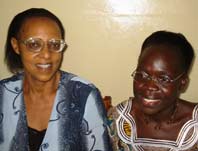
Friday
29 Nov.
We left the office at 8am, my guides for the day were Eugenie N Anacklet (health
personnel and correspondence analyst) and Agness Nshemele (project coordinator)
pictured right.
First we visited the primary school where I was welcome by dancing and singing
children. There is about 350 students and 10 teachers.
The
little girl pictured on the right, wanted, on behalf of all the children, to
say thank you to all the sponsors in Australia and to say hello to all the children
of Australia.
She also wanted to tell them what a difference to their life your help is doing;
thanks to them they are getting a good education, better health and a better
chance in their life.
She is the leader of the children committee which was established to discuss
the children affairs, especially their human's rights and responsibilities,
bad customs which discriminate a girl child, child labor and female genital
mutilation which is still wildly carried away in Tanzania.
Then
we had a meeting with all the members of the committee which informed me of
the progress of all the programs and the difference that it makes to the community.
We also had a look at the old water sources and at the new ones. A big pump
has being built which supply water to 7 individual points around the region.
To finish the visit we dropped in at the annual progress report of the sponsored
children
(320). That's where they report to the sponsor in Australia of the progress
of their sponsored child, take his or her picture and let the child write or
draw a picture for you. I really enjoyed hearing from the children and their
mums.
Once again I had a terrific day and it's so good to see how it all works, how
your money is spent and the difference that it makes. Thank you Eugenie and
Agness for taking the time to show me around, lunch was delicious. Children
with ride4kids stickers.
Saturday
30 Nov.
My next stop was Arusha, I had the choice of two ways, the short one, 400km
on a dirt road or the long one, 950km on tarmac, and I had no hesitation on
choosing the long one.
I
left the hotel of "comfort" at 7am, after 270km the scenery changed
to a very green tropical countryside, with an excellent road; I started to spot
Maasai people along the way (more about those people later on) and reached Moshi
at 5pm, 80km from Arusha but set at the foot of Mt Kilimanjaro, a perfect place
to stop for a couple of days. Obviously lots of tourist comes here to climb
it, as much as I would like to do that, my budget will not let me. It would
cost me around US$800 for a week long trek with no guaranties of clear views
at the
Les neiges du Kilimanjaro!
Bienvenue
en Tanzanie.
La Tazanie fait à peu prés une fois et demie la France, sa population
est de 38 million d'habitants. On y trouve les plus grands troupeaux d'animaux
sauvage sur le continent et aussi Mont Kilimanjaro, la plus haute montagne d'Afrique
(5892m).
Il y a aussi l'île de Zanzibar avec son exotique ville de pierre.
La capital, qui était Dar es Salam, est maintenant Dodoma depuis 1974.
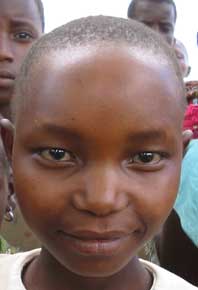
Mardi 26 Nov.
Le passage de la frontiere c'est encore une fois trés bien passé
à part que je me suis fait avoir en changeant de l'argent, je n'ai pas
perdu grand chose mais je n'aime pas me faire voler comme un débutant
mais des fois c'est difficile aux frontieres car on ne connait jamais le cours
de change et avec le stresse d'entrer dans un nouveau pays que l'on ne connait
pas, c'est facile de ce faire avoir.
Le paysage et le temps n'ont rien à voir avec la Malawie, les premiers
100km sont dans la montagne donc beaucoup plus frais et en plus il y a beaucoup
de brouillard. Il y a beaucoup de bananiers le long de la route et aussi d'autres
fruits tropicaux. Mais déja la route redescend vers les plaines ou la
chaleur revient
avec
la séchereusse.
Le soir je fais escale dans en camp dans la campagne ou je suis rejoins par
un overland camion (ceux sont des camions aménagés pour touristes
et ils parcourent les pays d'Afrique du sud) Ils m'invitent á partager
leurs repas et nous passons une agréable soirée autour d'un feu
de camp. Merci les gars.
Le lendemain je me levais à 5 heures, pliais la tente et prenais la route.
50km plus tard je m'arretais pour faire le plein à Iringa, je demande
la route pour Dodoma au pompiste, il m'indique deux routes possible, la premiere
sur une belle route goudronnée qui fait 600km, la deuxième, un
raccourcit sur un chemin de terre d'environ 250km, il me dit qu'avec ma moto
je n'aurai aucun problème. Je décide donc de prendre la route
la plus courte (mauvaise décision).
Les premiers km était vraiment mauvais mais je me disais cela va s'arranger,
je demandais aux gens et tous me disaient que la route était bonne, le
problème c'est que c'est la seule route qu'ils connaissent donc pour
eux elle est bonne, il faut dire aussi que la plupard des gens ne vont pas plus
loing que le village voisin. Toujours est il que je persistais et aprés
3 heures de route je n'avais couvert que 100 km, Je ne voyais plus personne
le long de la route, juste un village par ci par là. A un moment je rattrappe
un camion qui avance trés lentement 15km/h mais il n'y a pas la place
pour le passer, quand je suis derriere lui il y a tellement de poussiere qu'il
ne peut pas me voir, j'ai beau claxonné il ne sait pas que je suis derriere
lui et avec tant de poussiere je ne peus pas le suivre de prés. Donc
je m'arrête un peu pour le laisser prendre de l'avance mais forcément
je le rattrappe. Que faire ? Je le suis de loing trés lentement pendant
45mn environ et j'aperçois au loing que la route s'élargit un
peu, j'en profite pour le rattraper et j'essaye de le doubler, il me voit, je
ne sais pas comment je ne suis pas tombé car la moto est parti dans le
fossé plein de sable et de poussière mais j'ai réussi quand
mème à sauver la moto et à passer le camion, je continuais
content mais avec le coeur battant à fond. Un peu plus loing la route
n'était plus qu'un sillon de sable juste assez large pour me laisser
passer, j'avançais au pas, encor une fois je me dis, qu'est ce que je
fais, faire demie tour me prendrais 4 heures et qui sait peut être que
la route va s'améliorer plus loing. Je persistais et le chemin s'ameliorait
un peu, deux fois je suis tombé, sans gravitée mais relevé
la moto était le problème, il fallait enlever tout les baggages
sinon ce n'était pas possible. Toujours est il que 8heures plus tard
j'arrivais à Dodoma, épuissé et couvert de poussière.
Je trouvais un hotel avec un endroit sure pour garer ma moto, pas toujours facile
mais primordiale. La chambre consistait juste d'un lit et d'une petite fenêtre,
pas de meuble, de ventilateur ou de prise de courant. Tout ce que je voulais
c'etait de prendre une bonne douche, je demandais ou été les douches
" Désolé, mais il n'y a pas de douche içi, si vous
voulez prendre un bain je vais vous apporter de l'eau " Donc c'est avec
4 litres d'eau dans un seau que j'ai pris ma douche.
Il y a un manque d'eau dans cette région, l'eau est trés précieuse,
mème les toilettes n'ont pas de chasse d'eau, tout les matins une femme
de ménage vient vider un seau d'eau dans les toilettes, Je peus vous
dire que la premiere visite au toilette le matin, avant sa visite, n'est pas
trés appétissante et surtout ne faitez pas comme moi, apportez
du papier cul avec vous car il n'y en a pas, encore une fois je me suis fait
avoir, c'est ce que j'appelle être emmerder (voir photo). En un mot, cette
journée n'était pas la meilleur comme quoi on ne sait jamais qu'est
ce que le lendemain nous réserve. Pour la photo je plaisantais.
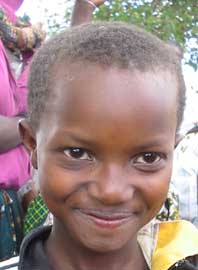
Vendredi
29 Nov.
J'avais organisé de visiter un autre World Vision project dans la région.
Nous avons donc visités Farkwa, un autre project supporté par
l'Australie.
Nous avons passés la journée à visiter l'école primaire,
les anciens et nouveaux points d'eau, parlés avec les responsables de
la communautée de façon à me faire voir les progrés
et la différence que l'argent des dons réalise.
Je descris d'une façon beaucoup plus appronfondie cette journée
dans la version Anglaise.
Le lendemain je quittais l'hotel tout " confort " et prenais la route
pour Arusha. Encor une fois j'avais le choix entre deux routes, la premiere
sur une route goudronnée
de
950km ou un racourci sur un chemin en terre de 400km seulement.Vous avez devinnés,
je prenais la route la plus longue, aprés 250 km le paysage changeait
complètement et la sécheureusse du centre faisait place a un paysage
trés verdoyant et trés tropical. La route était superbe
et je commençais à voir des Maasais (une tribue trés particuliere
habitant la région et aussi au Kenya). J'arrivais à Moshi à
5heures, petite ville au pied du Kilimanjaro et seulement à 80km de Arusha,
un endroit parfait pour quelques jours de repos.
Lundi 2 Dec.
Arusha, petite ville au pied de Mt Meru (4566m) est trés verdoyante
et riche en agriculture, on y trouve du café, maïs, blé
et bananes. Les 80km de Moshi à Arusha sont sur une route superbe,
je plantais la tente au Maasai campe. Aprés une courte visite au Bureau
national de World Vision ou l'on organisait une visite dans un village proche
pour le lendemain, je passais l'aprés-midi a faire une révision
tolale de la moto, vidange compris.
J'avais prévu entrer l'Uganda par le nord-west de la Tanzanie (voir
carte) mais on m'a dit que les routes sont extrèmement mauvaises dans
cette région donc j'ai décidé d'y aller par le Kenya
et ensuite de revenir au Kenya avant de continuer vers l'Ethiopie.
Ne manquez surtout pas mon prochain journal, il y aura une histoire sur les
Maasais, comment on traite le sida dans les régions isolées
et beaucoup d'aventures car les routes deviennent plus en plus mauvaises et
aussi beaucoup plus dangereuse.
top.
Next stop was Arusha, a city that sits in a lush, green countryside at the foot
of Mt Meru (4566m). Surrounding the town are many coffee,wheat and maize estates
tended by the Waarusha and Wameru tribespeople.
Monday 2 Dec.
It was a very pleasant and short ride. By 10am, I was at the Maasai camp, at
US$3 per night, camping was ideal. First I visited the National World Vision
office, I had a warm welcome and meet many people, we organised for me to visit
a project that was not on my list but important nevertheless (there will be
a full report of this visit in my next update).
Then I spent the afternoon working on my bike, servicing it and checking everything.
I had planned on entering Uganda, my next country, from North-West Tanzania,
around lake Victoria (see map) but I was told that the roads are from poor to
atrocious around there so I have decided to go there via Kenya.
Don't miss my next update as the roads are getting more and more difficult and
dangerous.
There will be a story on the Maasai people, what is done to fight HIV/AIDS in
remote arreas and a lot more.
Ckick here for more photos.
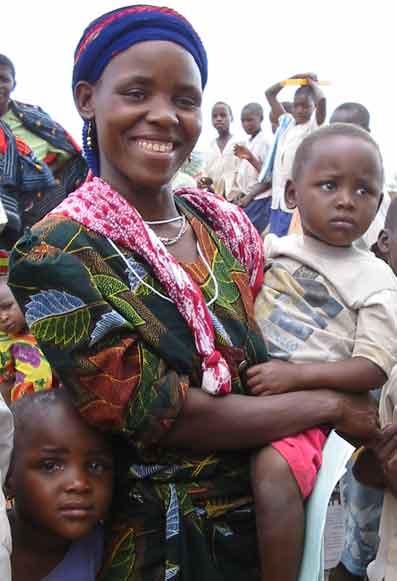
Woman and children in Farkwa.
Femmes et enfants in Farkwa.
School in Farkwa.
Ecole à Farkwa.
More children.
Encore des enfants.
Some of the mums.
Quelques une des mamans.
Mt Kilimanjaro.
Le Mt Kilimanjaro.
Servicing the bike.
Révision de la moto.
Maasai woman.
Femme Maasai.




